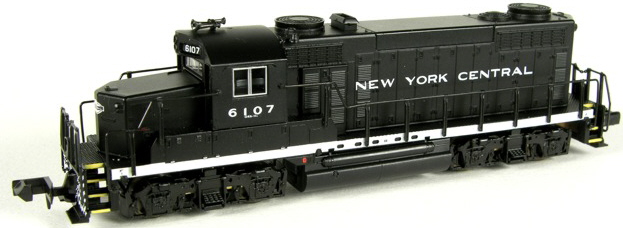

Introduced: 1999, 2005 (revised version), and 2011 (DCC-Ready version)
Starting with their 1997 SW9/1200 model, Life-Like began to gradually phase out their old line of wallet-friendly locomotive models in favor of higher-end offerings. And in 1999, Life-Like released the second in that line - their highly acclaimed GP20. This model was Life-Like's first real foray into Atlas/Kato country - it being basically a top-to-bottom imitation of those firms' diesel models -
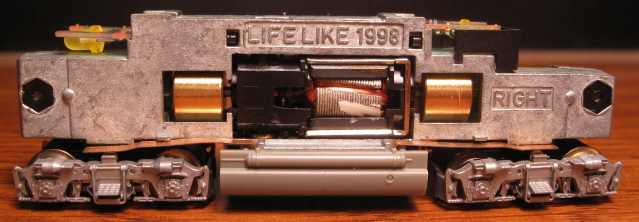
With the exception of DCC-readiness, this initial version had pretty much every feature we now associate with "modern" diesel models - IE, all-metal / split-frame chassis, skew-wound 5-pole motor, dual flywheels, low-friction drive/pickup, all-plastic gearing, bi-directional LED lighting, low-profile blackened wheels, shell-mounted Rapido-style couplers (easily swapped out for MT's), fine shell detailing, crisp paint, etc.
Performance on these models is perfect in every way - smooth, quiet, great throttle response, great pickup, great slow-speed creep, pulling power to spare, etc. And if Life-Like's equally impressive SW9/1200 put them on the map, it was this GP20 model that served to solidify their position as an elite player in N scale.
A second GP20 production run came out in 2005. Externally, the only change was to the couplers (Accumate rather than Rapido) -
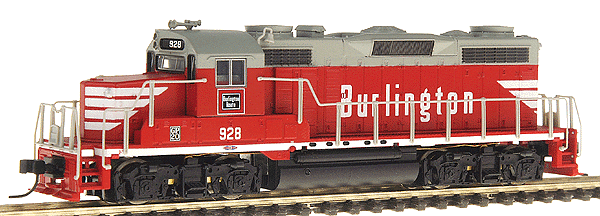
Internally, it incorporated the same chassis/mechanism used in Life-Like's 2004 GP18 model (and apart from some minor contour changes, virtually identical to the first-run GP20 chassis) -
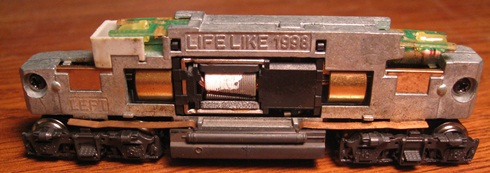
Unfortunately, this new production run not only gained a hell of a lot in the pricetag department (as compared to the economically priced first run), it also actually lost about a third of its pulling power. And after a bit of comparison testing, I narrowed the problem down to the wheels. The wheels on the first-run GP20 (as well as the 2004 GP18) have a brownish patina to them. Conversely, the wheels on the 2005 GP20 are polished like mirrors -
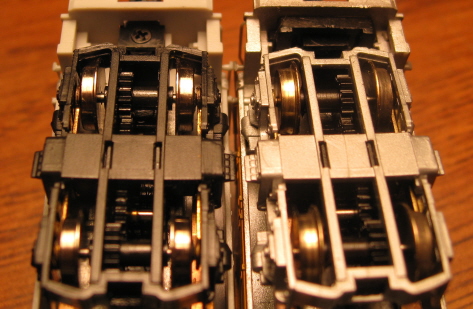
I guess the extra shiny wheels are prone to slipping. And unfortunately, they don't seem to get better with age. I've run my second-run GP20 around for hours and its pulling power increased not at all. Fortunately, the wheels look like they could be swapped out relatively easily. So, one could (in theory) increase pulling power by simply replacing the wheels.
In 2011, Life-Like (now owned by Walthers) completely redesigned the internals of their GP20 - providing (at long last) actual DCC-Readiness (the new chassis incorporating a single lightboard designed such that it can be swapped out in favor of a decoder). Said lightboard is equipped with bright white LEDs (as opposed to the yellow LEDs found in earlier releases).

The internal structure of the shell was modified a bit to acccommodate the slightly longer chassis. Unfortunately, this means that shells from earlier runs will not fit on said new chassis (not without some modification anyway). The trucks are also slightly different as compared to earlier versions - now having a plastic cover on the bottom to help keep the crud out of the gears.
Note that since Life-Like/Walthers did not change the third-run packaging to reflect the new change in DCC-Readiness, checking the bottoms of the trucks is pretty much the only way to differentiate a second-run GP20 from a DCC-Ready GP20 (both coming in identical Life-Like "Proto 2000" boxes). First-run GP20's are easily identified by their blue Life-Like boxes and Rapido-style couplers.
Like the previous two versions, this latest GP20 is a super smooth and quiet runner. Better still, the shiny wheels have been given the heave-ho, thus restoring pulling power to first-run levels (if not better). The only caveat is that it takes about an hour (or so) of running-in before pulling power perks up (right out of the box, mine could barely pull ten cars). Also, Life-Like went absolutely berserk with the wheel-blackening crud on these things, so you have to be vigilant about cleaning your track during said break-in period (where the wheel-blackening will gradually wear off the wheel surfaces). However, once suitably broken-in these are outstanding running models in every way.
Update - Atlas acquired the tooling for the Life-Like/Walthers GP20 (among other models) in 2018 and has announced revised DCC-Sound versions to be in the works for 2019.
Trivia - Circa 2001, Micro-Trains started spewing forth numerous custom painted GP20's - each whackier than the one before (and no doubt sending many an anal-retentive modeler to his or her premature grave) -
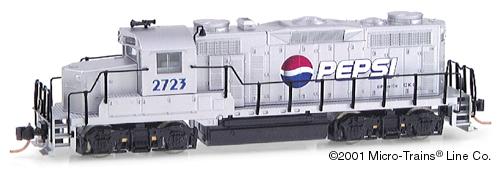
Grade: A (for all of 'em, although maybe A- for the second release)
First-run GP20 reviewed: 4/99 Model Railroader ("Life-Like has taken the quality of its N scale locomotives to a new level with this nicely detailed, good-running model of an EMD GP20 locomotive. It's the firm's first N scale road engine to feature an all-metal frame... Life-Like's model is made in China... This is an easy engine to work on. The lights are mounted on PC boards, eliminating internal wiring. The double-ended, five-pole, open-frame motor features a skewed armature and flywheels... The truck sideframes are superbly detailed. The wheels are chemically darkened to avoid the shiny look. The wheelset gauge checked out perfectly... However, the flanges measured just a tad (.005") too deep. All eight wheels pick up electricity... The model runs very well, although it's just a bit noisy... should be able to haul about 31 free-rolling cars... The paint job was well done, and other nicely done details include fine handrails, silver framing on the side cab windows, and numbers in the number boards. The horns and bell are especially delicate and well done. The model's dimensions match drawings... Life-Like's GP20 provides N scalers with an excellent model of a prototype previously available only in brass. ATSF, BN, NYC, SP, Price: $65")
Second-run GP20 reviewed: 06/05 Model Railroader ("Life-Like Products has released a nicely detailed and smooth-running N scale GP20. The Proto-N series model is factory-equipped with AccuMate magnetic knuckle couplers, prototype-specific dynamic brakes, directional LED headlights and illuminated number boards. Our sample was crisply painted and featured impressively fine lettering - even the tiny EMD builder's plate was neatly printed in correct blue, red and silver. The Life-Like GP20 closely matches prototype dimensions... The model's 3-piece body (cab, hood, sill) has a number of factory-added details, including bell, horns, radiator fans, and thin-profile acetal plastic handrails. The body slips off the chassis with a little tugging and wiggling, revealing a split-frame zinc-alloy chassis, a dual-brass-flywheel-equipped five-pole, skew-wound motor, and a pair of yellowish-white LED headlights. ll eight wheels pick up electricity, and all are powered... The GP20 performed smoothly and the model's slow-speed performance was especially good, inching along at just 4.3 mph. The locomotive's drawbar pull is about a half ounce, which is enough to haul only a 12 car train... The Life-Like GP20 is a good-looking model of EMD's first turbo-charged four-axle locomotive. AT&SF, BN, CB&Q, NYC, PC, SP, SF, UP, Undec. $97")